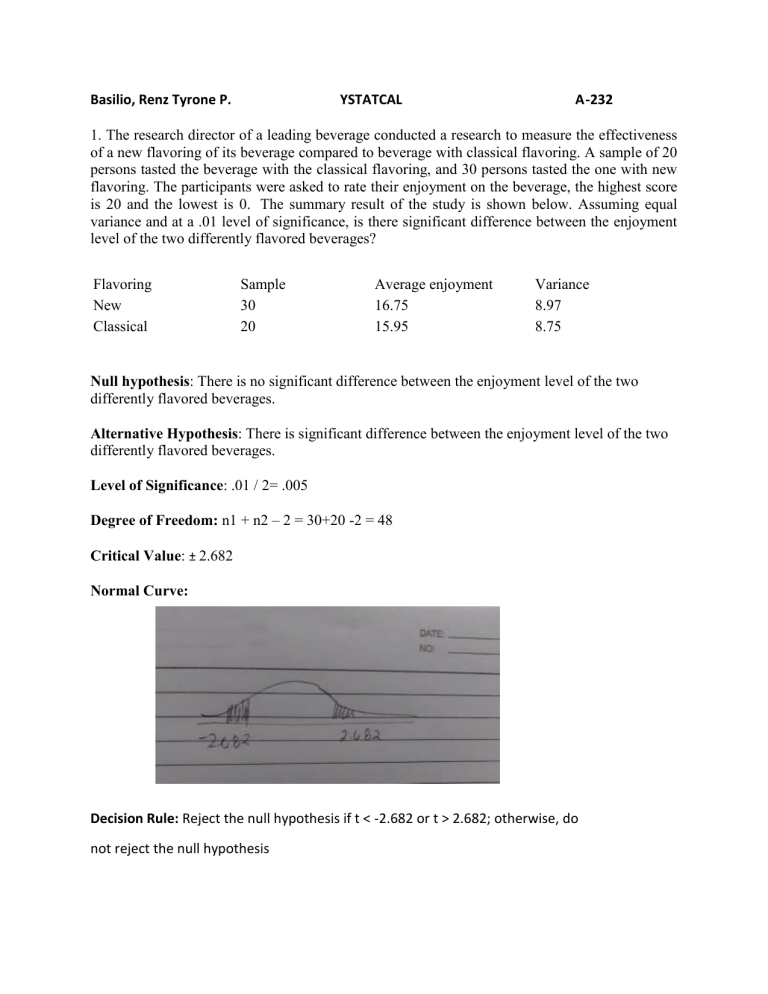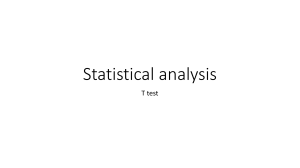
Basilio, Renz Tyrone P. YSTATCAL A-232 1. The research director of a leading beverage conducted a research to measure the effectiveness of a new flavoring of its beverage compared to beverage with classical flavoring. A sample of 20 persons tasted the beverage with the classical flavoring, and 30 persons tasted the one with new flavoring. The participants were asked to rate their enjoyment on the beverage, the highest score is 20 and the lowest is 0. The summary result of the study is shown below. Assuming equal variance and at a .01 level of significance, is there significant difference between the enjoyment level of the two differently flavored beverages? Flavoring New Classical Sample 30 20 Average enjoyment 16.75 15.95 Variance 8.97 8.75 Null hypothesis: There is no significant difference between the enjoyment level of the two differently flavored beverages. Alternative Hypothesis: There is significant difference between the enjoyment level of the two differently flavored beverages. Level of Significance: .01 / 2= .005 Degree of Freedom: n1 + n2 – 2 = 30+20 -2 = 48 Critical Value: ± 2.682 Normal Curve: Decision Rule: Reject the null hypothesis if t < -2.682 or t > 2.682; otherwise, do not reject the null hypothesis Computation: = 8.88 =0.930 Conclusion: Do not reject the null hypothesis, 0.930 < 2.682; which means there is no enough evidence to support that there is difference between the enjoyment level of the two differently flavored beverages. Recommendation: Based on the results, the two different flavored beverages are deemed to have no difference in their enjoyment level based on the sample t-test two sample test with samples of 30 and 20 respectively, average enjoyment of 16.75 and 15.95 respectively, variance of 8.97 and 8.75 respectively, and 0.005 as a level of significance. Based on this statistical result, it is recommended that the research director may continue serving these two different flavored beverages to the customers. Also, he can add new flavors to the beverage to provide the customers a set of curiosity to try new flavors. In that way, the customers will enjoy the beverage even more besides from tasting the classic flavor one. Through this new strategy, the company will cater the diverse preference of its customers, from those who stick to classic to those who want to explore different flavors 2. Two medical researchers looked into the effectiveness of a treatment for hypertension or high blood pressure. In a clinical trial, 45 patients with hypertensions were randomly assigned to either Group A (placebo control or Group B (treatment); and were closely monitored for three months. After which, the researchers measured and recorded the changes in the blood pressure of the patients in each group. The summary of the results is shown below. Assuming unequal variance and at .01 level of significance, is there evidence of significant difference on the change in blood pressures of the two groups of patients? Groups Sample Average change in blood pressure variance A (placebo control) 21 -0.218 16.81 B (treatment) 24 3.359 21.19 Null Hypothesis: There is no evidence of significant difference on the change in blood pressures of the two groups patients. Alternative Null Hypothesis: There is evidence of significant difference on the change in blood pressure of the two groups of patients. Level of Significance: .01 / 2 = .005 Degree of freedom: T-Test critical: ± 2.695 Normal Curve: = 43 Decision Rule: Reject null hypothesis if T > +2.695 or t < -2.695; otherwise, do not reject the null hypothesis T-Test Value: = -2.76 Conclusion: Reject the null hypothesis, -2.756 < - 2.695, which means there is enough evidence to support that the significant difference on the change in blood pressure of the two groups of patients. Recommendation: Based on the results, it was found that the treatment is infective because there is a significant difference on the change in blood pressures of the two groups of patients based on two sample test with sample of 21 and 24 respectively, average change in blood pressure of -0.218 and 3.359 respectively, variance of 16.81 and 21.19 respectively, and 0.005 as level of significance. Based on this statistical result, it is recommended that the treatment must not be administered to the public yet until it is proven fully effective. The researchers should look at the possible factors why the treatment is ineffective and make some necessary adjustments to fully achieve its expected benefit. Also, since the treatment is ineffective, they should rely this result to the participants involved in the study so that they may have their check up to know the complications that they may had after the test. Lastly, they might consider having two equal sets of participants to equally measure the effectiveness of the treatment.




